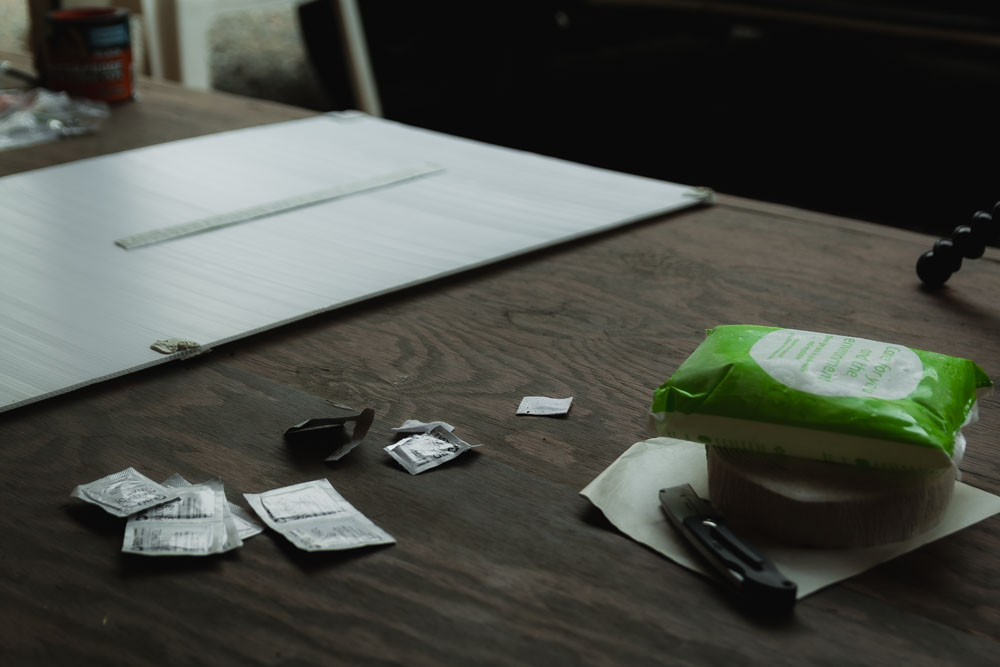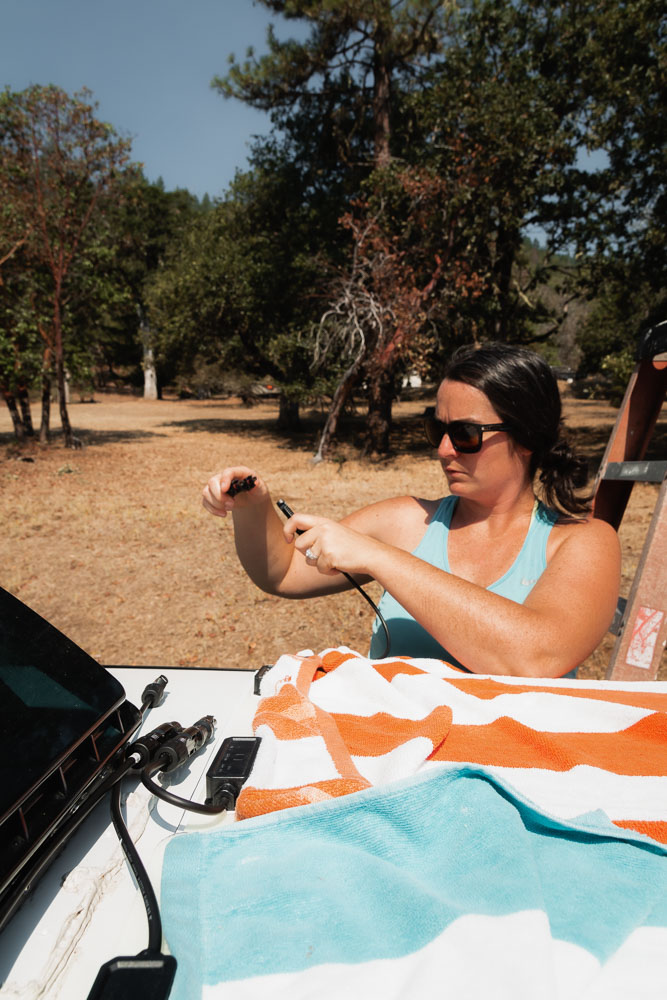ArboursAbroad contains affiliate links. As an Amazon Associate, we earn from qualifying purchases. If you purchase using one of the affiliated links, we may receive compensation at no extra cost to you. See our Disclosure Policy for more information.
Mounting flexible solar panels to van roof is a doozy. It’s a lot of steps.. hello, 31 of them.. but it’s a rewarding process! After all, you’re adding solar panels for van electricity.. you’ll be off the grid and in total peace in no time.
We’ve broken down this guide to mounting flexible solar panels to van roof in the simplest step by step instructions. Literally laying out things like removing the solar panels, covering them, and marking holes on the roof. If you’re looking for a complete list of everything you need to install and mount your solar panels, check out this ultimate flexible solar panel kit list. We lay out every single tool, nut, and bolt needed to fully install flexible solar panels on your van roof!
Before we move on.. this post is all about mounting flexible solar panels to your van roof. If you’re mounting rigid, hard solar panels to your roof, you’re in the wrong place, but you may like other how-to guides we have on the rest of our van build. Check them out here.


31 Steps to Mounting Flexible Solar Panels to Van Roof
- Purchase all flexible solar panel material
- Cut coroplast
- Lay out materials to make sure you have them all
- Clean van roof
- Place coroplast on roof for checking roof layout
- Mark all other roof gear
- Remove coroplast and place solar panels on roof
- Cover with blankets
- Connect panel cables
- Mark holes for entry points and bolts
- Drill holes for front four bolts
- File newly drilled holes
- Tentatively secure panels to roof with front four bolts
- Mark the remaining bolt holes
- Remove panels and drill remaining bolt holes
- File new holes
- Treat all new roof holes with Rustoleum
- Mark and drill holes in Coroplast
- Apply Butyl Tape to both sides of each bolt hole on coroplast
- Add 3-4 strips of Butyl Tape to middle of coroplast for connection to van roof
- Flip over and add 3-4 strips of Butyl tape to middle of coroplast for connection to solar panels
- Peel off paper tape cover and set solar panel on coroplast
- Set on van roof, flip up, and peel off paper backing
- Place bolts through grommets, press though Butyl Tape, and through drilled holes in roof
- Fasten washer, split lock washer, and Nylon lock nut – repeat for each bolt
- Cover solar panels with thick towels or blankets
- Install cable glands
- Connect solar panel cables and feed through cable glands
- Secure solar panel cables to roof with zip tie mounts
- Run Gorilla Tape along the front of each panel
- Cover each bolt with Gorilla Tape
Mounting Flexible Solar Panels to Van Roof in Detail


You didn’t think we’d leave you hanging, right?! Here’s a more detailed look at mounting your flexible solar panels to your campervan. You’ll find links to each tool and item used, as well as the reasoning behind why you need to do each of these steps.
1. Purchase all flexible solar panel materials.
Start your steps for mounting solar panels in the easiest way. Purchasing all your van solar system materials. I reckon that’s easier said than done though, as we found ourselves without items time and time again.
We didn’t want that to happen to you though, so we created the ultimate flexible solar panel kit. It has every single thing you need to purchase for mounting and installing flexible solar panels on your camper conversion. Check out our DIY flexible solar panel kit here.
2. Cut coroplast.
Coroplast is the material used to create a flexible solar panel air gap. The biggest issue people have with flexible solar panels are the panels themselves overheating creating heat spots. Installing coroplast between the solar panels and your van roof creates an air gap. Minimizing the risk of damage from heat spots.
3. Lay out materials to make sure you have them all.
If purchasing items from our DIY flexible solar panel kit, you will surely have every single item you will need to mount your flexible solar panels. However, it’s still nice to lay them all out in the sequence of how you will install them, so you can visualize your solar panel mounting step by step before actually starting the mounting process!
Make sure you do this in the shade. You do not want to let the solar panels sit under the sun. If in doubt, throw a thick towel or blanket over your solar panels to ensure the sun isn’t charging them!
4. Clean the van roof.
This is a no-brainer. You will be permanently mounting something on your roof, so you want to ensure it’s clean before mounting them. You won’t be able to access and clean under the panels once they’re mounted in place.
5. Place coroplast on the roof for checking roof layout.
Yes, I’m sure you have an idea in mind of the layout of your campervan roof. However, it’s a bit different when you have the actual materials laid out. Instead of using the solar panels to see how they fit, use the coroplast as placement holders are your campervan roof so you can see how they will actually lay.
Coroplast is especially good to use here when it’s sunny out. Because if there is sun hitting your solar panels, you will be collecting energy, and then have nowhere for that energy to go… plus, the solar panels are dark and get super hot… not nice to work with!
6. Mark other roof gear.
With your coroplast in place, mark where your other roof gear is going to be. We already installed our campervan roof fan, and knew where we thought everything else would go based on measuring it all out before. However, we learned the lights would need to be moved about half an inch for the solar panels to sit where they needed to. Super important to do this step just to double-check!
Once you know for sure where other things on your van roof will go, i.e. outdoor lights and bike mounts, mark the entry holes for them. If you haven’t yet installed your roof fan, use painter’s tape to mark off where the roof fan will go.
7. Remove coroplast and place solar panels on the roof.
Now that you’ve sorted out your final layout, you need to remove the coroplast cutouts and place the solar panels on the roof in their place.
Yes, we know we just said you don’t want to work with the solar panels while figuring out your van roof layout. However, you will need the panels on the roof for sorting out the entry holes for the solar panel cables.
8. Cover with blankets.
Immediately cover the solar panels with blankets. This will help protect the panels from scratches while you work through the next steps while also helping protect your body from being burnt from the heat radiating from the solar panels.
And just as we said above, the blankets block the sun from charging the solar panels, something you want to block until after they’re fully installed.
9. Connect panel cables, ensuring they still fit in the set location and wires are long enough.
We had a heck of a time connecting the solar panel cables. It should not be as difficult as we made it! Decide where you want your entry point for your cables.. this should be as close to the solar panels as possible, while still allowing for the cables to bend and flex to enter into the van.
You will want to keep the connection between these cables and the charge controller inside the van short, so do keep that in mind when deciding on an entry point as well.
When connecting the cables from two flexible solar panels, you’ll need one extender cord, a set of pair branch connectors, and a set of extender cables. These are all listed in the flexible solar panel complete kit.
10. Mark holes for cable entry points and bolts.
Make sure the solar panel cables have enough space to curve into the entry spots and mark your final entry points. This will be two different holes right next to each other… one for the positive solar panel cable and one for the negative cable.
While the solar panels are still in place, mark the holes for the front four bolts, (through the grommet holes on the panels). You will only want to do the front four here, as you want to do these one line at a time to ensure a perfect fit.
11. Drill holes for entry points for the solar panel cables and FRONT four bolts.
Detach the solar panel cables and remove your solar panels from the roof. Cover them back up with the towels. Drill front four bolt holes and solar panel cable entry point holes. Again, you only want to drill the front four holes, as shifting may occur when placing the panel on the roof and pulling it tight when installing bolts.
If you are adding lights, a bike mount, or anything else to your van roof, now is the time to drill those holes too.
12. File holes.
Using a small file, file down the holes to smooth any rough metal. If you have one person inside the van with a cardboard box underneath the holes, it helps keep the metal shavings from spreading all over the van!
13. Place solar panels on the roof, and tentatively secure with bolts fit in front four holes.
Grab your solar panels and put them back up on the roof. Remember to keep them as covered as possible in the process. Tentatively secure the panels with the bolts. You do not need to secure them super tightly yet. This is just to hold them in place to see exactly where the remaining bolt holes will be.
14. Mark other bolt holes through grommets.
Mark remaining bolt holes through the grommets. On our panels, we did the front four holes of both panels and the outside back hole of both panels.. leaving the center back grommet holes of both panels without a bolt. We did this to allow us to remove the panels if we had a problem later on down the line without having to take apart our entire van ceiling.
Your solar panels do not need to be secured in all six spots. You can secure it in each spot if you choose, however, know it’s not necessary.
15. Remove panels and drill newly marked holes.
Just like in step 11, remove the solar panels, covering them again with the towels wherever you set them. Drill the newly marked holes (the remaining bolt points for your solar panel). Again, it’s nice to have someone else inside the van with a cardboard box catching the metal shavings.
16. File holes.
Using a small file, file down the holes to smooth any rough metal. If you have one person inside the van with a cardboard box underneath the holes, it helps keep the metal shavings from spreading all over the van!
17. Treat all van roof holes with Rustoleum.
Spray all around the area of the newly exposed metal with Rustoleum. Rustoleum is a spray paint that stops and prevents rust. It’s perfect for curing newly exposed metal. Use a cardboard box or just a piece of cardboard to stop the spray paint from going where you don’t want it to.
18. Mark and drill holes on coroplast.
While you let the Rustoleum dry, lay the solar panels on the coroplast pieces and mark and drill/poke holes for the bolts on the coroplast.
19. Apply Butyl Tape to both sides of each bolt hole on the coroplast.
This step means you’re getting so stinking close to actually having your solar panels on the roof. Butyl tape is a tape that is commonly used on RVs as a water seal for holes on the roof. Most RV shops carry Butyl tape, and we actually found it cheaper at a local RV store than on Amazon. However, we’re linking to Amazon for convenience and so you know what it is!
Clean the area around each newly drilled hole on one side of the coroplast. Cut a square piece of Butyl tape and stick to the coroplast, leaving the paper on the exposed side. Do this for each bolt hole on both the top an the bottom of the coroplast.
Remember, do not peel off the paper yet! If your Butyl tape is sticky, stick it in the freezer for a bit.. it makes it easier to work with. We also kept an ice pack on it while it was out in the heat as we were using it.
20. Add 3-4 strips of Butyl Tape to middle of coroplast for connection to van roof.
Adding 3-4 strips of Butyl tape to the middle of your coroplast is to secure it to your van roof. Butyl tape is one of the only things that actually sticks to polypropylene (the coroplast). You will also be bolting down the coroplast and solar panels, so this is really just an extra security measure.
If you’re super concerned with the solar panels going anywhere, use 3M VHB LSE Double Sided Tape, it’s one of the only other adhesives that actually sticks to the coroplast.
Again, do not remove the paper covering on the tape yet.
21. Flip over and add 3-4 strips of Butyl tape to middle of coroplast for connection to solar panels.
Adding 3-4 strips of Butyl tape to the middle of your coroplast is to secure it to your solar panels. Butyl tape is one of the only things that actually sticks to polypropylene (the coroplast). You will also be bolting down the coroplast and solar panels, so this is really just an extra security measure for if the coroplast rips at each of the bolt holes.
If you’re super concerned with the coroplast or solar panels going anywhere, use 3M VHB LSE Double Sided Tape, it’s one of the only other adhesives that actually sticks to the coroplast.
22. Peel off paper tape cover and set solar panel on coroplast.
Yay! You’re removing the tape and making the coroplast and solar panels into one thing! This is an exciting step.. Don’t get too excited though.. only remove the paper from one side of the coroplast to stick the panels on top!
Make sure the back side of your solar panels (where the tape is sticking) is clean. Use alcohol wipes to ensure nothing is on it!
23. Set on van roof, flip up, and peel off paper backing.
Now you can remove the rest of the Butyl tape paper. Make sure your van roof is clean. If it’s too hot out, your Butyl tape will be a sticky mess, so best to do this step when it’s not scorching!
24. Place bolts through grommets, press through Butyl Tape, and through drilled holes in roof.
Grab all your bolts. You’ll be sticking them through each of the grommet holes, coroplast holes, and roof holes. You’ll have to really push to get them through the Butyl tape too.
25. Fasten washer, split lock washer, and Nylon lock nut – repeat for each bolt.
Now’s the time for a definite two-person job – one on the outside with screwdriver, one on the inside with a closed-end wrench. You’ll be fastening the flat washer, split lock washer, and nylon lock nut onto each bolt on the inside of the campervan. You’ll want to do so in that order, starting with the washer first. Using a screwdriver on the top, screw the bolt in place, while someone on the inside holds the nylon lock nut securely in one position.
Repeat this process for each bolt.
26. Cover solar panels with thick towels or blankets.
Cover both solar panels completely. You will want them to be completely covered from now until you hook up your battery and charge controller, and then the solar panels to the charge controller.
Need insight on what a good battery is check out this post about the best leisure campervan battery. Then check out this in-depth review on the lithium batteries we just installed by Goldenmate.
27. Install cable glands.
Cable glands are a gift from above. Not a single mounting and installing solar panel guide that we read or watched talked about the cable glands. Cable glands create a waterproof sealed entry point for the cables running from the solar panels into the inside of the van. You literally cannot install your solar panels without them, so I’m not sure why we’ve never heard of them before!
Anyways… install the cable glands. This is perfect to do while one person is still inside the van, as you’ll need to hold one side tight while screwing on the cable gland from the exterior of the van.
28. Connect solar panel cables and feed through cable glands.
When connecting the cables from two flexible solar panels, you’ll need one extender cord, a set of pair branch connectors, and a set of extender cables. These are all listed in the flexible solar panel complete kit.
Basically, all you’re doing in this step is making the power from two solar panels feed through one cable instead of two separate cables, while also extending the solar panel cables so they can reach the charge controller.
29. Secure solar panel cables to roof with zip tie mounts.
Again, one of those things that no other mounting flexible solar panels how to video or blog post mentioned.. securing the solar panel cables to the roof. Unlike the rigid, hard solar panel cables, the flexible solar panel cables are super awkward coming off one end of the solar panel, and they cannot be just tucked underneath, directly into the van.
With the flexible solar panels, you’ll need to use zip ties and zip tie mounts to secure the cables to the roof. Use construction adhesive or 3M VHB LSE tape for securing, the mounting tape they come with sucks!
30. Run Gorilla Tape along the front of each panel.
We mounted our flexible solar panels to a minivan roof. There was limited space, and the shape of the roof is super rounded. So, we were really worried about the wind draft coming up the roof and getting underneath the flexible solar panels. To prevent this from happening, we ran waterproof Gorilla Tape along the entire front of both panels.
After putting thousands and thousands of miles on the van, driving up to 80 mph, this has held up great! It’s just that added peace of mind, preventing lift-off from occurring while driving!
31. Final Step for Mounting Flexible Solar Panels to Van Roof Cover each bolt with Gorilla Tape.
Since we had the Gorilla Tape out and had a ton of extra, we decided to add an extra waterproofing barrier to the top of each bolt. To do so, simply cover each bolt with a patch of Gorilla Tape. We like to think this also adds a bit of security, so people can’t see how the solar panels are attached to the van roof.










More on Camper Van Solar Panel Systems
Complete Material List for Mounting and Installing Flexible Solar Panels
Best Solar Panels for Van Life
Read Next About Campervan Conversions
Choosing the Best Campervan Stove for you Build
9 Mistakes Made When Installing Our Van Flooring
How to Insulate Campervan Floor
How to do Laundry While Living in a Van
Camper Lighting Options | ways to light up your campervan
Save This Post for Quick Reference Later



Did you like this post on mounting flexible solar panels to van roof? It truly helps us tremendously when you save and share our posts with others! It’s a great way to show this post was helpful and we should write more like it in the future. Use these pictures to pin this post on Pinterest! Want to support us in a different way? Find out how here.









